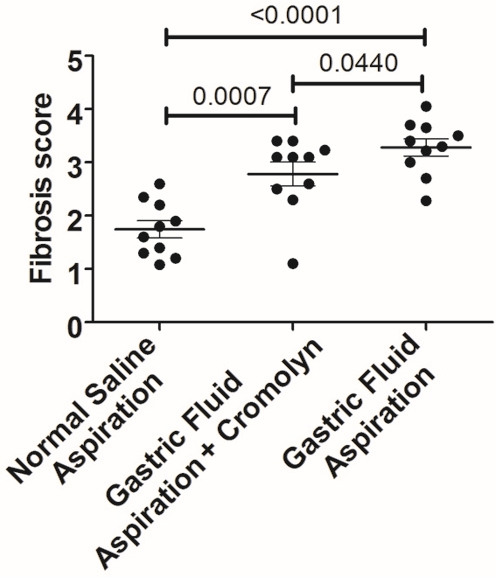Effects of Mast Cell Stabilization on the Development of Aspiration-Induced Fibrosis in a Rat Model
Surgery, Duke University Medical Center, Durham, NC.
Meeting: 2015 American Transplant Congress
Abstract number: A248
Session Information
Session Name: Poster Session A: Preclinical Immunosuppression and Tolerance
Session Type: Poster Session
Date: Saturday, May 2, 2015
Session Time: 5:30pm-7:30pm
 Presentation Time: 5:30pm-7:30pm
Presentation Time: 5:30pm-7:30pm
Location: Exhibit Hall E
Gastric fluid aspiration affects a great number of lung transplant recipients, both before and after the transplant, and can contribute significantly to morbidity and mortality. With the hypothesis that mast cells are instrumental in the pathogenesis of aspiration-induced lung injury, the objective of this study was to investigate the effects of cromolyn, a well-established mast cell stabilizer, on the pathogenesis of pulmonary fibrosis in a rat aspiration model.
Male Fischer 344 rats were aspirated weekly with 700 ul/kg of gastric fluid for 8 weeks with (GFC, n=10) and without (GF, n=10) treatment with cromolyn (150 mg/kg subcutaneously daily and 50mg/ml aerosolized prior to aspiration events). Controls (n=10) received aspiration with saline only. Airway inflammation, parenchymal fibrosis (Figure), and average mast cell numbers per airway were significantly reduced in the GFC group compared to the GF group (p=0.0256, 0.0440, and 0.004, respectively). However, no significant difference in perivascular infiltrates between the GF and GFC groups was observed. Cromolyn improved lung compliance (p=0.0269 compared to GF at 250 mmH2O) and reduced IL-12p40 and TGF-β1 in the bronchoalveolar lavage fluid of the GFC group compared to the GF group. Further, a significant reduction in IL-12p40, VEGF-α, and CCL11 in the lung parenchyma of the GFC group compared to the GF group was observed.
This study suggests that cromolyn therapy dampens the development of pulmonary fibrosis by affecting key immunologic players in the fibrotic pathway. Reduced IL-12p40 may reflect a decrease in macrophage activation, and reduced levels of VEGF-α and CCL11 in lung parenchyma may indicate reduced vascular permeability and chemotaxis of eosinophils, respectively. Cromolyn also appears to reduce fibrosis by reducing TGF-β1, a known promoter of fibroblast proliferation and subepithelial fibrosis. This study suggests that mast cells are important in the pathogenesis of aspiration-induced fibrosis, and that clinical trials with cromolyn in this setting may be worthwhile.

To cite this abstract in AMA style:
Sapmaz E, Sun Z, Chang J-C, Sanders N, Bell S, Everett M, Holzknecht Z, Parker W, Davis R, Lin S. Effects of Mast Cell Stabilization on the Development of Aspiration-Induced Fibrosis in a Rat Model [abstract]. Am J Transplant. 2015; 15 (suppl 3). https://atcmeetingabstracts.com/abstract/effects-of-mast-cell-stabilization-on-the-development-of-aspiration-induced-fibrosis-in-a-rat-model/. Accessed December 15, 2025.« Back to 2015 American Transplant Congress
